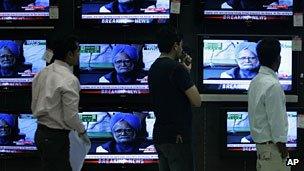Why are India's media under fire?
- Published
- comments

There are more than 80 news channels in India
Has the explosion of media in India been a mixed blessing?
With more than 70,000 newspapers and over 500 satellite channels in several languages, Indians are seemingly spoilt for choice and diversity.
India is already the biggest newspaper market in the world - over 100 million copies sold each day. Advertising revenues have soared. In the past two decades, the number of channels has grown from one - the dowdy state-owned broadcaster Doordarshan - to more than 500, of which more than 80 are news channels.
But such robust growth, many believe, may have come at the cost of accuracy, journalistic ethics and probity.
The media has taken some flak in recent months for being shallow, inaccurate and sometimes damagingly obtrusive. Former Supreme Court judge and chairman of the country's Press Council, Markandey Katju, fired the first broadside, exhorting journalists to educate themselves, external more. Predictably, it provoked a sharp reaction from the media.
Economist Amartya Sen is the latest to join the list of critics after being wrongly quoted in the mainstream media a couple of times recently. There are at least two huge barriers, writes Dr Sen in a recent article, external, to the quality of Indian media.
One is about professional laxity which leads to inaccuracies and mistakes. The other, he says, is a class bias in the choice of what news to cover and what to ignore.
Dr Sen offers unexceptional solutions to ensure accuracy - newspapers should publish corrections (a few like The Hindu, external and Mint , externalalready do) and journalists should be given more training. He suggests that reporters should make use of recorders during interviews rather than take rushed notes for accuracy - in fact, many reporters do use recorders and even when they don't, they usually do take correct notes. But stories can sometimes get mangled on their way to publication, resulting in inaccurate headlines.
Dr Sen's worry about lack of training is more pertinent. Most Indian newsrooms have no legacy - or practice - of editorial training. They still host energetic, sharp and argumentative journalists. But analysts say many newsrooms do lack rigour and there is a crying need for some serious, consistent training in fact checking and reporting ethics.
Dr Sen's other grouse about the class bias in Indian newsrooms is valid but again unexceptional. Class bias in newsrooms, say media pundits, is prevalent in big media all over the world. But class bias in reporting on a country where more than a third of its people live in abject poverty has more serious implications. Journalists can easily become uncritical cheerleaders for a high growth, low equity society.
Does this also have to do with low minority participation in newsrooms?
A 2006 study by the Delhi-based Centre for the Study of Developing Societies found that of the 315 key decision-makers surveyed from 37 Hindi and English publication and TV channels, almost 90% of decision makers in the English language print media and 79% in television were from the upper castes. There is virtually no representation, external of Dalits (formerly known as untouchables), who comprise some 20% of India's population and live on the margins. This accounts for a serious lack of diversity in Indian media.
Indian media houses can look to US newsrooms for inspiration. In 1975, fewer than 4% of journalists in newsrooms were from black and other minorities. Three years later, the editors pledged that minorities must get proportionate representation in all newspapers. They offered scholarships and organised job fairs. By 2000, more than 60% of the nearly 1,500 American newspapers had abided by the pledge. It was a major triumph for news diversity. Cannot Indian papers do something similar?
Dr Sen actually misses the bigger crises in Indian media.
There are serious concerns about trivialisation of content and the increasing concentration, external of media ownership in the hands of large corporate groups. There is now the culture of non-stop breaking news and, some fear, the transformation of news into a commodity.
Most seriously, there is the scourge of what is called paid news, which involves influential people - mainly politicians - paying newspapers and news channels for positive coverage. It became widespread in the run-up to the 2009 elections.
A 71-page Press Council investigation, external named leading newspapers that had received money for publishing information disguised as news in favour of individuals, including senior politicians. Paranjoy Guha Thakurta, an independent journalist who was one of the investigators, says a lobby of big publishers pushed the Press Council to water down the report. Even Vice President Hamid Ansari regretted the development, saying that the Press Council's inability to come out with the report was "a pointer to the problems of self-regulation and the culture of silence in the entire industry when it comes to self-criticism".
How do you stop this? Journalists like Mr Guha Thakurta argue for increased transparency, self-regulation and competition regulation.